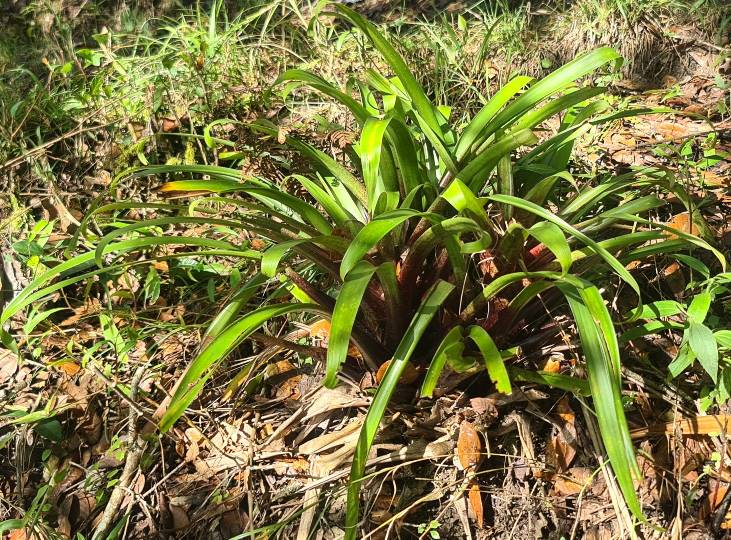


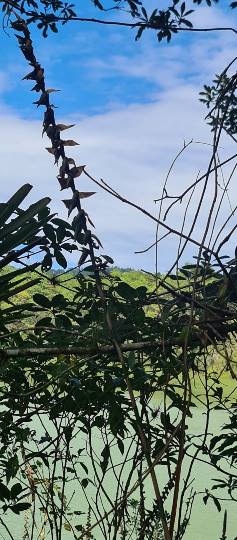
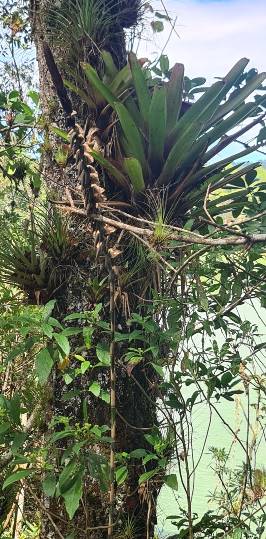

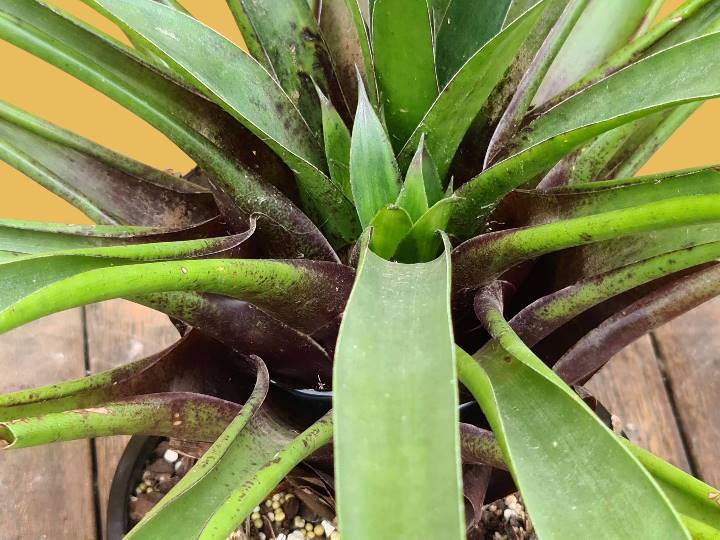
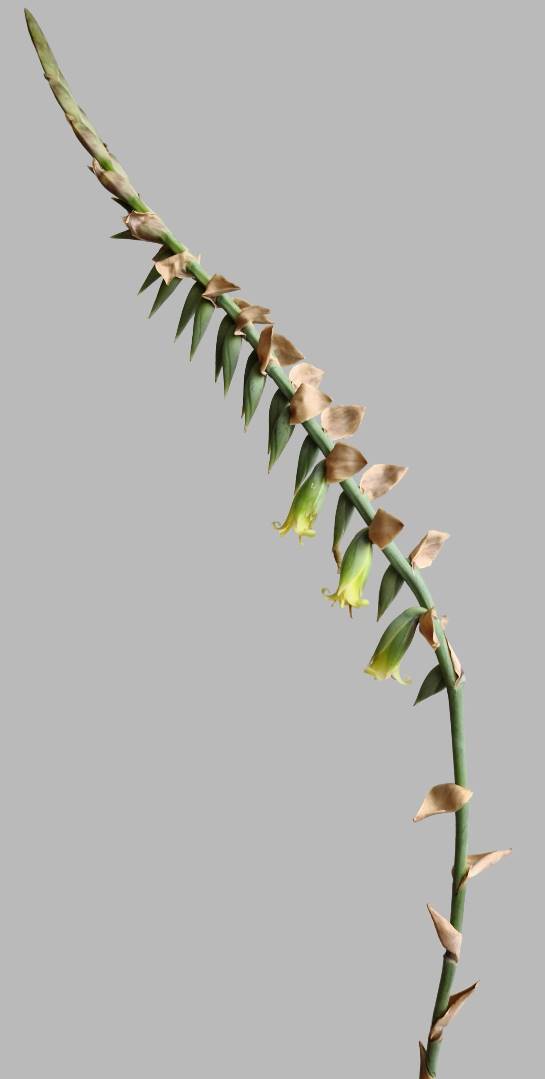
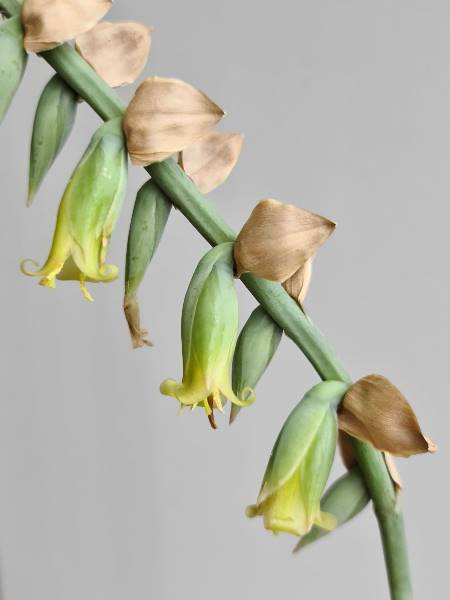
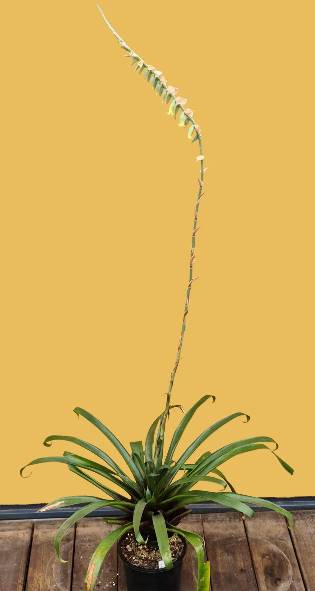
Vriesea capitata (Mez & Werckle) L. B. Smith & Pitt. J. Wash. Acad. Sci. 43: 402. 1953.
Thecophyllum capitatum Mez & Werckle in Mez, Bull. Herb. Boiss. ser . 11.4: 873. 1904.
TYPE: COSTA RICA: no location given, Werckle Bromel. Costaric. 86 (HOLOTYPE: B!, photograph US!).
Desc from Tulane 1983
Epiphytic, acaulescent to 5.5 cm caulescent.
LEAVES in an ascending to suberect rosette, 23.7-40.0 cm long;
- blades 11.5-17.5 cm long and 3.6-4.5 cm wide, green frequently suffused with purple or maroon distally, ligulate apex acute to rounded and apiculate;
- sheaths 12.0-17.0 cm long and 5.5-7.0 cm wide, castaneous abaxially, brown adaxially, margins suffused with purple to maroon distally.
SCAPE erect, 22.5-35.0 cm long and 0.4-1.0 cm in diameter;
- bracts 4.2-7.6 cm long,
- blades 1.2-2.6 cm long and 1.1-2.0 cm wide, green drying to brown, erect or frequently recurved, triangular or short ligulate, apex attenuate to acute or rounded and abruptly acuminate,
- sheaths 2.6-5.0 cm long and 2.1-3.3 cm wide, drying ochre or brown castaneous proximally, sheathing erect, ovate to elliptic or oblong elliptic.
INFLORESCENCE erect, 3.5-6.5 cm long and 4.0-6.5 cm in diameter, subcapitate;
- primary bracts 2.3-3.8 cm long, blade 0.7-1.4cm long and 0.5-1.4. cm wide, green becoming brown at anthesis, spreading, triangular, apex acute,
- sheaths 1.9-2.9 cm long and 2.2-2.6 cm wide, green elliptic to ovate in outline.
LATERAL BRANCHES ascending, 3.8-5.2 cm long, subcollaterally 2-flowered, peduncle 0.1-0.3 cm long rachis about 0.4 cm long.
FLOWERS sessile,
- floral bracts 2.0-2.2 cm long and 1.3-1.6 cm wide, green subcoriaceous, brown-centered lepidote adaxially, glabrous abaxially, oblong to obovate, unkeeled or very weakly keeled distally, apex obtuse;
- sepals 2.0-2.2 cm long and 1.3-1.6 cm wide, olive green, coriaceous, brown-centered lepidote adaxially, glabrous abaxially, elliptic to obovate, apex obtuse;
- petals about 3.1-3.4 cm long and 1.5-1.6 cm wide, white, obovate;
- appendages 0.4 cm long and 0.2-0.25 cm wide;
- stamens in a hood configuration over the gynoecium,
- filaments about 2.3 cm long
- anthers about 0.7 cm long;
- ovary about 0.7 cm long and 0.5 cm in diameter,
- style 1.7 cm long;
- capsules 4.1 cm long and 0.8-1.0 cm in diameter, casteneous, fusiform.
PHENOLOGY: Flowering plants have been collected only during August.
DISTRIBUTION AND HABITAT: Known from Costa Rica and a few recent collections from Cerro Jefe in Panama. Collected between 900-1400 m in premontane rain forest life zone possibly extending slightly into the premontane wet forest life zone.
DISCUSSION: Vriesea capitata remains a poorly collected taxon. In locations where I have collected this species, I have never seen more than one or two individuals in flower or fruit. It is characterized by its rigidly coriaceous leaves in a subascending to suberect rosette, subcoriaceous primary bracts which are divergent to subspreading at anthesis, and its subcapitate inflorescence. The inflorescence of V. capitata is often totally covered with a gelatinous exudate. The developing floral buds are immersed in this gelatinous matrix until anthesis, at which time the white, campanulate nocturnal flowers emerge. When the atmospheric humidity is low, this exudate will dry on the flower buds and inhibit anthesis.
Vriesea capitata is most closely related to V. bracteosa and the characters which distinguish these taxa are discussed under the latter species.
SPECIMENS EXAMINED: COSTA RICA: ALAJUELA PROVINCE: along road between Hwy. 9 and Laguna Hule between 0.5-5.0 km northwest of Cariblanco, 16 October 1974, Utley & Utley 1368 (DUKE); north of San Ramon, between Los Angeles Norte and about 7 km north, 15 December 1974, Utley & Utley 1635 (CR) & 1651 (DUKE). BORDER OF ALAJUELA AND HEREDlA PROVINCES: vicinity of Colonia Virgen del Socorro about 3-6 km east of Cariblanco, 10 August 1975, Utley & Utley 2878 (DUKE). BORDER OF HEREDIA AND SAN JOSE PROVINCES: about 5 km northeast of San Isidro de Heredia on Calle Yerbabuena, 3 Apri11976, Utley & Utley 4475 (NOLS) & 4477 (DUKE). PANAMA: PANAMA PROVINCE: Cerro Jefe, December 1974, Mori & Kallunki 3619 (MO), 18 December 1974, Mori & Kallunki 3800 (MO).
Detail from Utley, J. F. Bromeliaceae. In: Flora Mesoamericana. 6: 131. 1994
Translated by Butcher
41. V. pectinata Lyman B. Smith, Lilloa 6: 387 (1941). Holotype: Guatemala, Standley 69055 (F!).
Vriesea chiapensis Matuda.
Rupicolous, terrestrial or epiphytic, 70-125 cm high in flower.
Leaves with the sheaths c. 8 cm wide, sharply spotted with purple at the apex, sparsely lepidote to glabrescent;
Blades 3.2-4.8 cm wide, dense brown lepidote, ligulate, long acuminate.
Peduncle 70-80 cm long, erect;
bracts shorter than internodes, amplexicaul, erect.
Inflorescence 33-60 cm long, simple, erect with 22-42 flowers.
Floral bracts 2.5-3.2 cm long, broadly ovate, acute, erect, arranged slightly unilaterally at anthesis, finely carinate to ecarinate, coriaceous, smooth and green.
Flowers patent to reflexed, unilaterally arranged at anthesis;
pedicels 7-10 mm long;
sepals 2.2-3 cm long, smooth, coriaceous, glabrous;
Petals white.
Capsules c. 2.5 cm long.
Pinus-Quercus forests. Ch (Utley and Utley 7563, MEXU); (G) (Steyermark 43884, F). 1300-2200 m. (endemic.)
In view of the great similarity between Vriesea pectinata and V. chiapensis and the variable character which distinguishes them, scape bracts shorter than the internodes vs. bracts of scape slightly more long that the internodes, are considered both under the same species.
Desc from S&D
93. Vriesea pectinata L. B. Smith, Lilloa (Contr. Gray Herb. 137) 6: 387, 393,pl.1,figs. 10-13. 1941. Fig 375 A-B.
Plant flowering over 1 m high.
Leaves ca 5 dm long;
blades ligulate, acuminate, over 3 cm broad, concolorous, sparsely brown-punctulate-lepidote on both sides.
Scape erect, 8 mm in diameter, glabrous;
scape-bracts all shorter than the internodes, broadly ovate, acute, closely enfolding the scape, brown-punctulate, even.
Inflorescence simple, densely many-flowered, 6 dm long; rhachis flexuous, faintly angled, glabrous.
Floral bracts becoming secund with the flowers, broadly ovate, acute, minutely cucullate, to 32 mm long, more than twice as long as the internodes, obtusely carinate, coriaceous, faintly nerved when dry, green, brown-punctulate;
flowers secund-spreading; pedicels stout, ca 1 cm long.
Sepals broadly elliptic, acute, 23 mm long, ecarinate, coriaceous;
petals narrowly elliptic, obtuse or emarginate, 28 mm long, bearing 2 large acute scales at base, greenish yellow when dry;
stamens included, filaments slightly thickened toward apex.
Type. Standley 69055 (holotype F), Coban, Alta Verapaz, Guatemala, Mar-Apr 1939.
DISTRIBUTION. Terrestrial and epiphytic, 1300-2000 m alt, Guatemala.
GUATEMALA. ALTA VERAPAZ: Tactic, 10 Apr 1941, Standley 92027 (F); San Cristobal Verapaz to Chixoy, 19 Feb 1942, Steyermark 43884 (F, GH, US). EL PROGRESO: Calera to Volcan Siglo, 20 Jan 1942, Steyermark 43010 (F, GH).
Desc from S&D
110. Vriesea chiapensis Matuda, An. Inst. Biol. Mexico 23: 130. 1953.
Plant flowering 7-8 dm high.
Leaves many in a dense rosette, 6-7 dm long;
sheaths broadly elliptic, 20 cm long, 8 cm wide;
blades ligulate, long-acuminate, over 25 mm wide, densely brown-punctulate on both sides.
Scape erect, 5 mm in diameter, glabrous;
scape bracts all slightly longer than the internodes, broadly ovate, acute, tightly clasping, brown-punctulate.
Inflorescence simple, densely many-flowered, 6 dm long; rhachis erect, slightly angled, glabrous.
Floral bracts secund with the flowers, broadly ovate, acute, 25-32 mm long, more than twice as long as the internodes, carinate, coriaceous, pale brown when dry;
pedicels stout, 8 mm long.
Sepals narrowly elliptic, obtuse or emarginate, 30 mm long;
stamens included, filaments slightly thickened toward apex.
Type. Ramirez 178 (holotype MEXU n v), Monte Bello, near Comitan, Chiapas, Mexico, 2 Dec 1951.
DISTRIBUTION. Moist woods, 1500-1600 m alt, Chiapas, Mexico.
MEXICO. CHIAPAS: Bochil to Jititol, 25 Dec 1968, Beutelspacher s n (MEXU, US).